Michelin revamps its CrossClimate
New compound and new tread design for the second generation of the French group's four-season tire
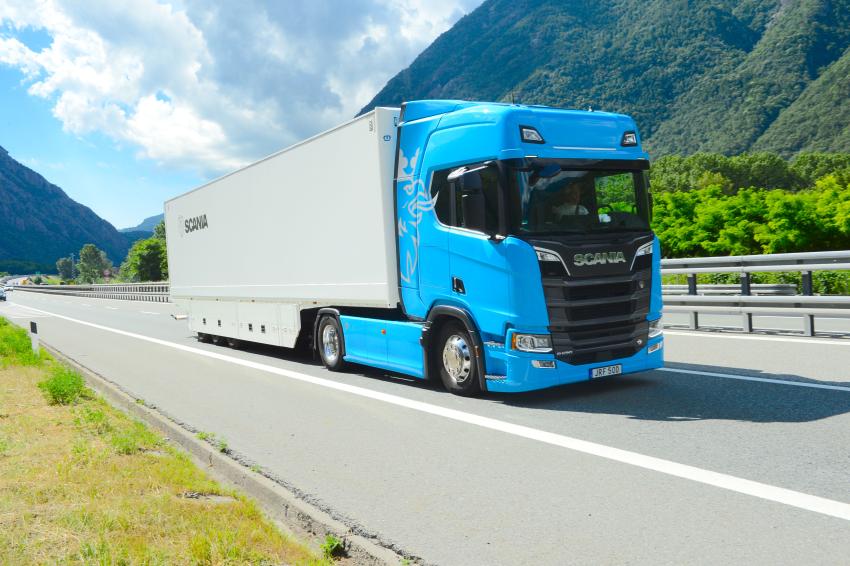
Trucks are evolving and so are their tires: in recent years safety and environmental sustainability, especially for transport vehicles, have increased significantly, thanks to the combined effect stemming from the improved performance of their components. Among these, tires. However, technology, as one would expect, proceeds at a different pace compared to fleet renewal policies. Depending on the use, trucks, trailers and semi-trailers are scrapped after a period ranging between ten to twenty years from their registration, and during this time they could travel over a million kilometres; new tires, on the other hand, hit the market every year. Tires are an expensive and long-lasting component and will generally be regrooved twice and retreaded once during their life span and must therefore be chosen wisely considering the use and performance of the truck. In this article we consider three main missions: long-distance haulage, distribution and regional transport, and severe winter use on snow and ice. These can help, but they are by no means the only parameter that should guide a fleet manager in the choice. A shuttle service between depots in the Po Valley, for example, is a task suitable for long-haul tires even if the distance covered is limited to a couple of hundred kilometres a day, just as a longer route over mountain roads and passes can benefit from a regional tire designed for winding roads and variable weather. For routes crossing the Alps and Apennines, the use of specific winter tires should be considered, useful in periods when snow and ice are the norm, while if only occasional snowfalls are encountered, tires with winter markings such as M+S and, even more so, the 3PMSF, which certifies that the tire has passed a specifically regulated test, are often sufficient. The article takes into consideration the offer of eight premium brands concerning road tires for 19.5" and 22.5" wheels, usually used on heavy duty vehicles (18 t fully loaded for two-axle lorries, 44 t for articulated trucks and tractor-trailers), leaving out those up to and including 17.5" wheels, typically found on distribution vehicles.
Bridgestone
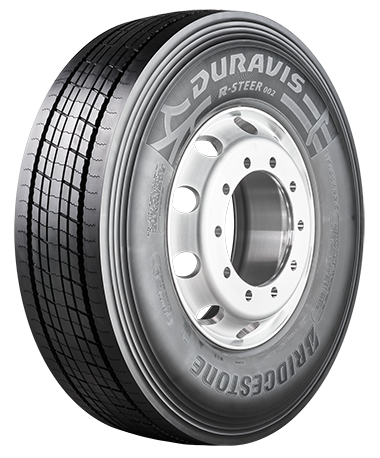 Bridgestone Ecopia represents the Japanese giant’s offer for the long-haul transport sector with three models: H-Steer 002, H-Drive 002 and H-Trailer 002, dedicated respectively to steering axles, drive axles and trailers, with M+S and 3PMSF markings for both steering and trailer axles. The low-deformation casing supplies the perfect support to the High Silica Nano Pro Tech compound which promises to reduce rolling resistance and ensure low operating temperatures. The rolling resistance and traction efficiency of the steering and drive axle tires are at the top of the category. The same compound is used on the Duravis series (R-Steer 002, R-Drive 002 and R-Trailer 002), dedicated to regional and medium-long distance transport. The tread has been redesigned to improve water drainage, and the component mixing process ensures even wear. H-Steer and H-Trailer are M+S and 3PMSF marked. Specific to winter use are the RW-Steer 01, designed for optimized contact, and the Nordic Drive 001 Drive with microscopic-pore Multicell compound and convex tread blocks.
Bridgestone Ecopia represents the Japanese giant’s offer for the long-haul transport sector with three models: H-Steer 002, H-Drive 002 and H-Trailer 002, dedicated respectively to steering axles, drive axles and trailers, with M+S and 3PMSF markings for both steering and trailer axles. The low-deformation casing supplies the perfect support to the High Silica Nano Pro Tech compound which promises to reduce rolling resistance and ensure low operating temperatures. The rolling resistance and traction efficiency of the steering and drive axle tires are at the top of the category. The same compound is used on the Duravis series (R-Steer 002, R-Drive 002 and R-Trailer 002), dedicated to regional and medium-long distance transport. The tread has been redesigned to improve water drainage, and the component mixing process ensures even wear. H-Steer and H-Trailer are M+S and 3PMSF marked. Specific to winter use are the RW-Steer 01, designed for optimized contact, and the Nordic Drive 001 Drive with microscopic-pore Multicell compound and convex tread blocks.
Continental
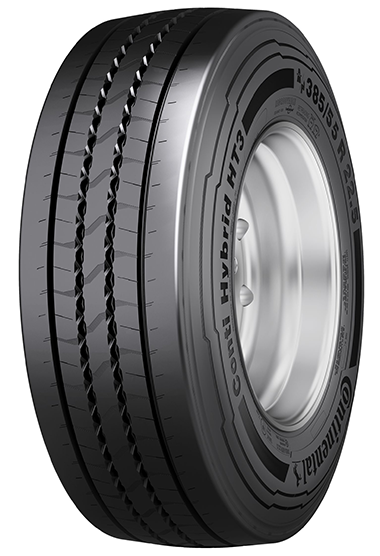 The Ecoplus range, including its more evolved version Ecoplus +, already available as steering and drive axle tires, is the German group’s workhorse in the field of long-haul transport. Thanks to the new compound and a new tread profile specifically designed for every type of use (in particular the pocket sipes on the steering version, the bevelled profiles of the traction tire and the grooves on the trailer version), this tire promises to reduce rolling resistance while maintaining excellent performance in terms of grip. The Hybrid version for regional routes offers a self-healing design that ensures excellent residual depth even after traveling over many miles. The Hybrid Plus range is also available for drive and trailer applications; while more specialized products such as High Load, Severe Regional and Extreme Duty are also available. A specific tread for regional routes combined with low rolling resistance identifies the Eco Regional range, available for steering and traction axles. Conti Scandinavia, on the other hand, represents the winter choice, available also as Conti Re retreads. The latter features a reinforced bead, triangular belt and inner liner that improves air tightness.
The Ecoplus range, including its more evolved version Ecoplus +, already available as steering and drive axle tires, is the German group’s workhorse in the field of long-haul transport. Thanks to the new compound and a new tread profile specifically designed for every type of use (in particular the pocket sipes on the steering version, the bevelled profiles of the traction tire and the grooves on the trailer version), this tire promises to reduce rolling resistance while maintaining excellent performance in terms of grip. The Hybrid version for regional routes offers a self-healing design that ensures excellent residual depth even after traveling over many miles. The Hybrid Plus range is also available for drive and trailer applications; while more specialized products such as High Load, Severe Regional and Extreme Duty are also available. A specific tread for regional routes combined with low rolling resistance identifies the Eco Regional range, available for steering and traction axles. Conti Scandinavia, on the other hand, represents the winter choice, available also as Conti Re retreads. The latter features a reinforced bead, triangular belt and inner liner that improves air tightness.
Giti Tire
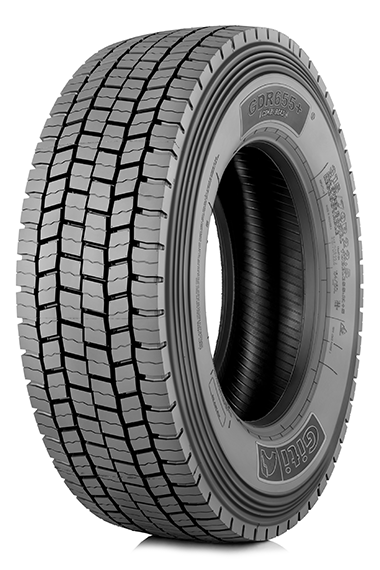 The Indonesian rubber multinational, known as GT Radial until the middle of the last decade and replaced in 2017 by the current logo is distributed in Italy by Magri Gomme of Carpenedolo (BS), and just as the previous two manufacturers boasts a rather comprehensive range. All the tires listed here have 3PMSF markings; the intended use of the individual model is more evident from the range name than from the acronyms. Giti’s offer for the heavy-duty vehicles segment includes many sizes for 17.5" (not considered in this review) and 19.5" wheels with the same basic characteristics as the 22.5". The GAL 817, GDL 617 and GTL 919 and 925 models are long distance steering, drive and trailer tires respectively. Intended for mixed and regional use, the Combi Road offers the GSR 225 and 259 steering models, the GDR 655, 655+ and 665+ tractor units and finally the GTR 955 trailer unit; for this use the catalogue also offers a regional series, intended exclusively for 17.5 or 19.5" wheels. Finally, the Winter series consists of the two models GSW 226 and GDR 621, respectively designed for drive and steering axles.
The Indonesian rubber multinational, known as GT Radial until the middle of the last decade and replaced in 2017 by the current logo is distributed in Italy by Magri Gomme of Carpenedolo (BS), and just as the previous two manufacturers boasts a rather comprehensive range. All the tires listed here have 3PMSF markings; the intended use of the individual model is more evident from the range name than from the acronyms. Giti’s offer for the heavy-duty vehicles segment includes many sizes for 17.5" (not considered in this review) and 19.5" wheels with the same basic characteristics as the 22.5". The GAL 817, GDL 617 and GTL 919 and 925 models are long distance steering, drive and trailer tires respectively. Intended for mixed and regional use, the Combi Road offers the GSR 225 and 259 steering models, the GDR 655, 655+ and 665+ tractor units and finally the GTR 955 trailer unit; for this use the catalogue also offers a regional series, intended exclusively for 17.5 or 19.5" wheels. Finally, the Winter series consists of the two models GSW 226 and GDR 621, respectively designed for drive and steering axles.
Goodyear
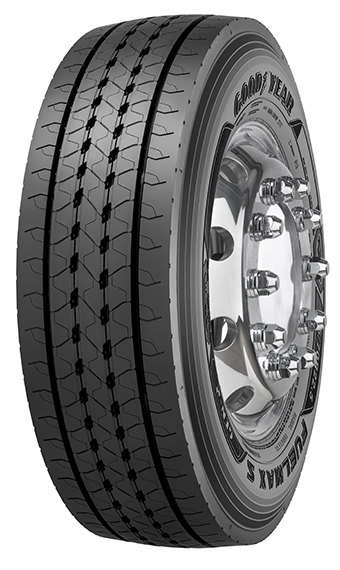 The company named after the person who invented the vulcanization process has always invited users to consider the characteristics of their prevailing routes rather than lengths or bureaucratic definitions of road type. A journey across Italy from North to South, for example, is better suited to a regional/interregional tire than one designed for long distances. This is why Goodyear has developed extremely specific ranges such as Fuelmax Performance, focused on fuel savings (all models in the series are labelled A for energy efficiency) and also suitable for partial use on state roads, or the very recent Fuelmax Endurance (see page xx) which promises significant savings compared to a classic "regional" tire (labeled B) while maintaining its renowned strength, durability and road holding. Purely regional is the Kmax, designed to offer durability. The classic 22.5” model has been joined by a 19.5" version for the Fuelmax and Kmax Gen 2 for trailers; the Kmax is available in these two diameters as well as 17.5".
The company named after the person who invented the vulcanization process has always invited users to consider the characteristics of their prevailing routes rather than lengths or bureaucratic definitions of road type. A journey across Italy from North to South, for example, is better suited to a regional/interregional tire than one designed for long distances. This is why Goodyear has developed extremely specific ranges such as Fuelmax Performance, focused on fuel savings (all models in the series are labelled A for energy efficiency) and also suitable for partial use on state roads, or the very recent Fuelmax Endurance (see page xx) which promises significant savings compared to a classic "regional" tire (labeled B) while maintaining its renowned strength, durability and road holding. Purely regional is the Kmax, designed to offer durability. The classic 22.5” model has been joined by a 19.5" version for the Fuelmax and Kmax Gen 2 for trailers; the Kmax is available in these two diameters as well as 17.5".
Hankook
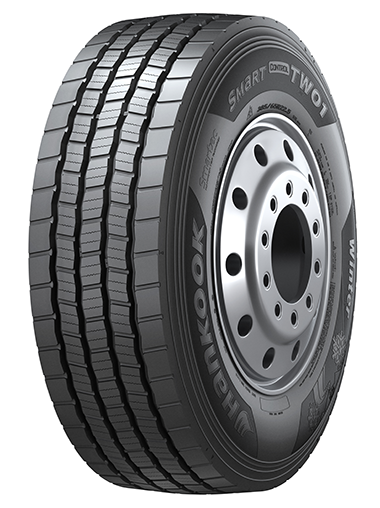 In recent years, the Korean company has earned major OE supply contract through ongoing research and development. Its product lines are known for low noise levels and the presence of many models labelled A or B for energy efficiency. The company’s catalogue is basically divided into three tire ranges designed for long haulage (with the E-Cube offered in three variations), regional transport and winter (Smart Control), with the second divided between the traditional TJ 22, reserved for trailers, and the more technological Smart Flex. The catalogue stands out for at least two peculiarities: the absence of tires classified for steering axles (all models suitable for drive axles and trailers work well also on the front axle), and the presence of many sizes from the old series, such as the 8R 17.5 and the 10R, 11R, 12R and 13 R 22.5. Many of these, generally intended for older vehicles, with the exception of the 13R 22.5 (still in use in the quarry-site sector, even on newly registered vehicles), feature respectable levels of energy performance and wet grip.
In recent years, the Korean company has earned major OE supply contract through ongoing research and development. Its product lines are known for low noise levels and the presence of many models labelled A or B for energy efficiency. The company’s catalogue is basically divided into three tire ranges designed for long haulage (with the E-Cube offered in three variations), regional transport and winter (Smart Control), with the second divided between the traditional TJ 22, reserved for trailers, and the more technological Smart Flex. The catalogue stands out for at least two peculiarities: the absence of tires classified for steering axles (all models suitable for drive axles and trailers work well also on the front axle), and the presence of many sizes from the old series, such as the 8R 17.5 and the 10R, 11R, 12R and 13 R 22.5. Many of these, generally intended for older vehicles, with the exception of the 13R 22.5 (still in use in the quarry-site sector, even on newly registered vehicles), feature respectable levels of energy performance and wet grip.
Michelin
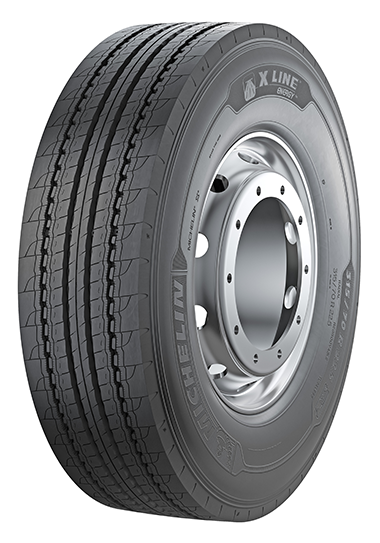 It is rather difficult to summarize Michelin’s offer, divided as it is between main product lines and niche solutions such as the steering XFN 2 Antisplash designed to reduce the amount of water projected on other vehicles. In most ranges, the three classic positions (steering, drive and trailer) are combined in a multi-position tire although the catalogue maintains the relevant specific models. For long distance haulage, the company proposes its X Line and X Line Energy tires, all intended for the 22.5" diameters while the 19.5" is managed with the XTA line. The regional X Multi range is also flanked by a low fuel consumption proposal (X Multi Energy) and by many other products focused on specific missions; the 19.5" size is also the prerogative of the XTE 2 line. The X Multi line includes the X Multiway 3D, again for regional use but also suitable for short off-road routes, and the X Multi Winter (multi-position or trailer) and X Multi Grip (multi-position or traction), designed for the winter season and for 22.5" wheels. Only XTA 2 Energy and X Line Energy are pure summer tires, all the others have M+S or 3PMSF markings (present on most of them).
It is rather difficult to summarize Michelin’s offer, divided as it is between main product lines and niche solutions such as the steering XFN 2 Antisplash designed to reduce the amount of water projected on other vehicles. In most ranges, the three classic positions (steering, drive and trailer) are combined in a multi-position tire although the catalogue maintains the relevant specific models. For long distance haulage, the company proposes its X Line and X Line Energy tires, all intended for the 22.5" diameters while the 19.5" is managed with the XTA line. The regional X Multi range is also flanked by a low fuel consumption proposal (X Multi Energy) and by many other products focused on specific missions; the 19.5" size is also the prerogative of the XTE 2 line. The X Multi line includes the X Multiway 3D, again for regional use but also suitable for short off-road routes, and the X Multi Winter (multi-position or trailer) and X Multi Grip (multi-position or traction), designed for the winter season and for 22.5" wheels. Only XTA 2 Energy and X Line Energy are pure summer tires, all the others have M+S or 3PMSF markings (present on most of them).
Pirelli
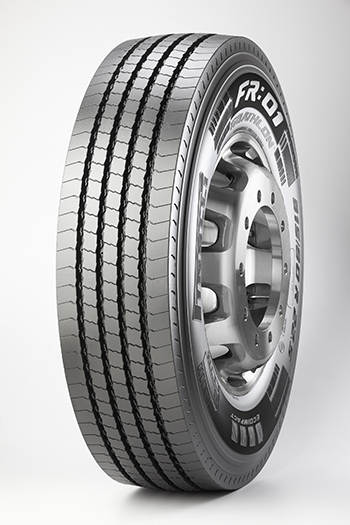 The premium brand of the Prometeon group offers a wide selection of choices for 22.5" wheels, with three ranges dedicated to long-distance haulage, two for regional routes and one for winter. Acronyms and brand names are not uniform due to the extensive renovations that have affected the product lines over the last ten years, in which alphanumeric acronyms have been flanked by range names for new products. All Pirelli products, thanks to research and development work on casings and compounds, offer excellent performance in terms of wet grip; every model in the series considered is classified as winter with the dual marking M+S and 3PMSF, with the exception of the ST:01 Neverending which is only M+S. The FH:01 Proway and FH:01 Energy series have been designed for steering axles while the TH:01 caters for traction axles and the ST:01 Neverending is the proposal for trailers. The two FR:01/TR:01/ST:01 Triathlon and Itineris Drive/Itineris Steer ranges look at regional applications, while for winter, the FW:01 and TW:01 tires are for steering and traction axles, respectively. Applications for 19.5" wheels have been entrusted to the FR:01/TR:01/ST:01 series, while 17.5" wheels can rely on Triathlons.
The premium brand of the Prometeon group offers a wide selection of choices for 22.5" wheels, with three ranges dedicated to long-distance haulage, two for regional routes and one for winter. Acronyms and brand names are not uniform due to the extensive renovations that have affected the product lines over the last ten years, in which alphanumeric acronyms have been flanked by range names for new products. All Pirelli products, thanks to research and development work on casings and compounds, offer excellent performance in terms of wet grip; every model in the series considered is classified as winter with the dual marking M+S and 3PMSF, with the exception of the ST:01 Neverending which is only M+S. The FH:01 Proway and FH:01 Energy series have been designed for steering axles while the TH:01 caters for traction axles and the ST:01 Neverending is the proposal for trailers. The two FR:01/TR:01/ST:01 Triathlon and Itineris Drive/Itineris Steer ranges look at regional applications, while for winter, the FW:01 and TW:01 tires are for steering and traction axles, respectively. Applications for 19.5" wheels have been entrusted to the FR:01/TR:01/ST:01 series, while 17.5" wheels can rely on Triathlons.
Yokohama
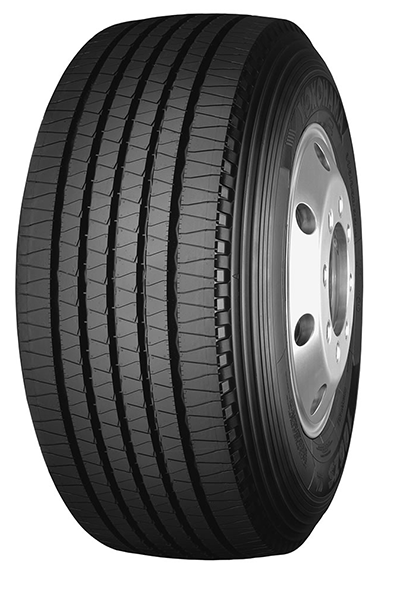 The comprehensive range offered by the Japanese manufacturer includes two lines focusing on low emissions and environmental compatibility (Bluearth, for long haul, and Zenvironment, suitable for both long haul and regional transport) and a large number of individual models for the three standard positions, for the regional range and multi-position. Bluearth technology involves the use of recycled materials such as those that make up 80% of the Nano Blend Compound, which allows for a significant reduction in tire weight. The Advanced Inner Liner waterproofing layer reduces pressure loss and therefore the risk of damage and increased consumption caused by driving with insufficient pressure. Zenvironment technology, exclusive to truck tires, reduces rolling resistance and evens out tire wear. Nearly all Yokohama models boast top class wet performance, while M+S marking is limited to about half of the tires considered; the 902W alone also offers 3PMS certification. The 17.5” wheel can be equipped with the Y793R (multi-position) and Y785R (trailer); the Zenvironment 104ZR series, on the other hand, offers many sizes from the old series (9, 10, 11 and 12 R22.5).
The comprehensive range offered by the Japanese manufacturer includes two lines focusing on low emissions and environmental compatibility (Bluearth, for long haul, and Zenvironment, suitable for both long haul and regional transport) and a large number of individual models for the three standard positions, for the regional range and multi-position. Bluearth technology involves the use of recycled materials such as those that make up 80% of the Nano Blend Compound, which allows for a significant reduction in tire weight. The Advanced Inner Liner waterproofing layer reduces pressure loss and therefore the risk of damage and increased consumption caused by driving with insufficient pressure. Zenvironment technology, exclusive to truck tires, reduces rolling resistance and evens out tire wear. Nearly all Yokohama models boast top class wet performance, while M+S marking is limited to about half of the tires considered; the 902W alone also offers 3PMS certification. The 17.5” wheel can be equipped with the Y793R (multi-position) and Y785R (trailer); the Zenvironment 104ZR series, on the other hand, offers many sizes from the old series (9, 10, 11 and 12 R22.5).
New compound and new tread design for the second generation of the French group's four-season tire
Lots of vehicles, lots of tires: this is how commercial fleets could be described. It is a fact that the silver medal on a hypothetical podium of the major fleet expenses goes to fuel costs (the gold medal goes to salaries), which are notoriously linked to tire pressure
That fact that the automotive industry is undergoing huge changes is clear to everyone. Less obvious are the developments affecting all brands in the tire industry
